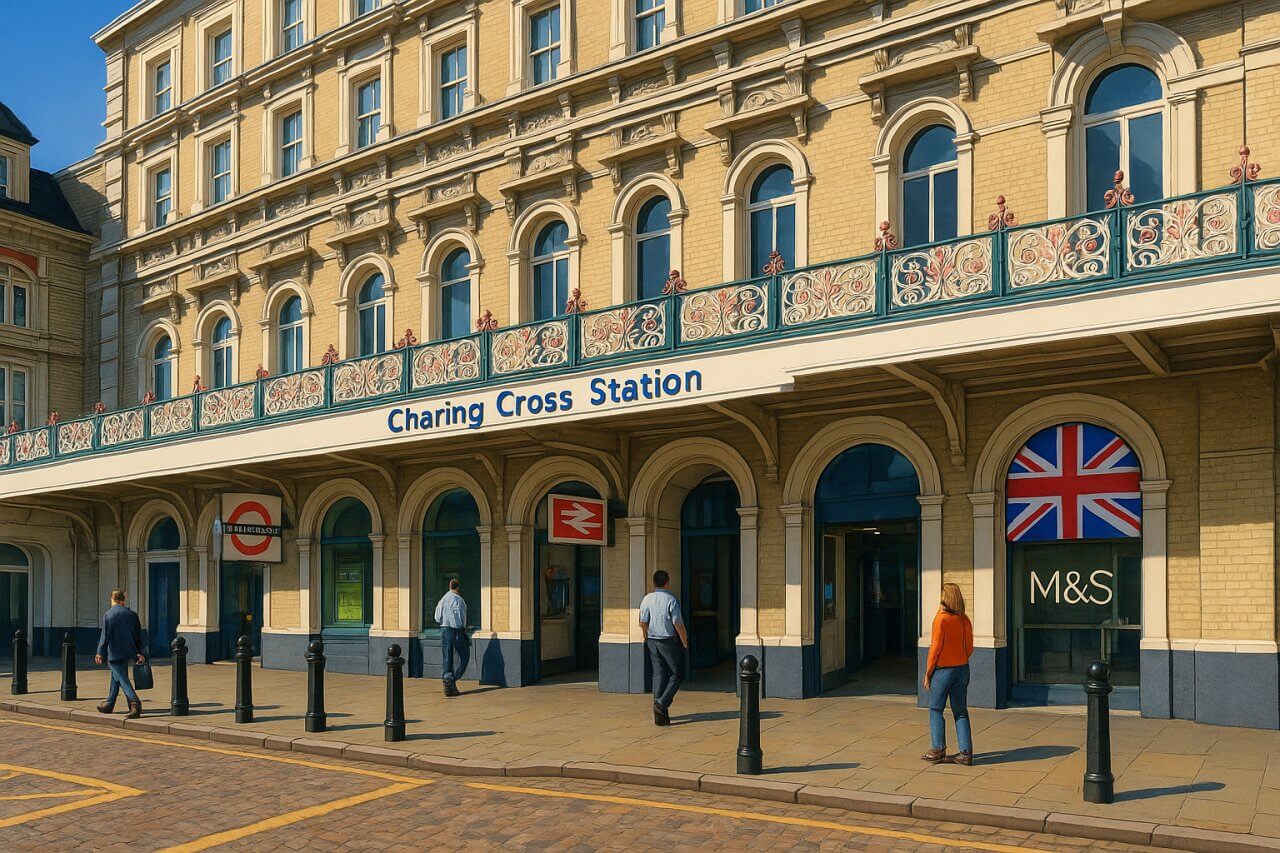
Charing Cross Station, London
Charing Cross Underground Station is a centrally located London Underground station situated in the City of Westminster, directly adjacent to the Strand and at the southern end of Trafalgar Square. This strategic location places it at the heart of London’s West End, serving as a major hub for both commuters and tourists.
Location and Entrances
The main entrances to Charing Cross Underground Station are found on the Strand and within the concourse of the National Rail station of the same name. There are additional pedestrian access points from Villiers Street and Adelaide Street.
There is no prominent standalone ground-level building solely for the Underground station. Instead, access is integrated with the larger Charing Cross railway terminus and the Embankment Place development, which includes office spaces and amenities directly above the tracks of the mainline station.
Distance to Charing Cross Traffic Junction
Despite the station’s name, the actual Charing Cross traffic junction—considered the notional centre of London—is located about 100 metres west of the station entrances, where Whitehall, Strand, and Cockspur Street converge. Standing prominently outside the station is a replica of the Eleanor Cross, marking the spot from which distances to London are traditionally measured.
Rail Services at the Station
Charing Cross Underground Station is served by the London Underground network only. While the National Rail station above it offers overground services, the Underground and mainline stations are distinct, albeit closely integrated.
The Underground station is served by the following lines:
- Bakerloo line: Between Embankment (southbound) and Piccadilly Circus (northbound)
- Northern line (Charing Cross branch): Between Embankment (southbound) and Leicester Square (northbound)
Note that the station is not served by the Jubilee line, despite historical connections—see below.
History of the Station
Charing Cross Underground Station opened in stages. The Bakerloo line platforms opened on 10 March 1906 under the name “Trafalgar Square.” The Northern line platforms opened as part of the Strand station on 22 June 1907. The two lines operated independently until the 1970s.
In 1973, the station complex was unified and renamed Charing Cross. As part of this process, the Strand and Trafalgar Square stations were merged, and new pedestrian tunnels were created to connect the platforms.
The Jubilee line platforms opened at Charing Cross in 1979 as part of the original Jubilee line route but were later closed to passengers in 1999 when the Jubilee line was extended to the east via Westminster and Waterloo. The disused Jubilee platforms are still maintained and are often used for staff training and film productions.
Origin of the Station Name
The name “Charing Cross” was adopted in 1973 to reflect the integration of the Bakerloo and Northern lines and to align with the National Rail terminus above. The name itself is derived from the original Charing Cross, a monument erected in the 13th century by King Edward I in memory of his wife, Eleanor of Castile. A Victorian-era replica of the Eleanor Cross stands in front of the station today.
Interesting Facts
- The now-closed Jubilee line platforms at Charing Cross are frequently used as film and television sets. Scenes from films such as Skyfall and Paddington were shot there.
- The station has two original entrances that were once separate tube stations—Strand (Northern line) and Trafalgar Square (Bakerloo line).
- Because of its central location and proximity to Trafalgar Square and the West End, Charing Cross Underground Station is one of the most convenient access points for London’s major cultural landmarks.
Nearby Landmarks
The station is ideally situated for visiting:
- Trafalgar Square
- The National Gallery
- St Martin-in-the-Fields Church
- London Coliseum
- Covent Garden (a short walk east)
Quick Facts
- Name: Charing Cross Underground Station
- Location: Under Charing Cross railway station, between Strand, Villiers Street, and Adelaide Street
- Underground Lines: Bakerloo and Northern (Charing Cross branch)
- Preceding/Following Stations:
- Bakerloo: Embankment ↔ Piccadilly Circus
- Northern: Embankment ↔ Leicester Square
- Opened: 1906 (Bakerloo as Trafalgar Square), 1907 (Northern as Strand), unified in 1973
- Named After: The Eleanor Cross replica and nearby historic junction of Charing Cross
- Special Feature: Disused Jubilee line platforms used for films and training
- Distance to Charing Cross junction: Approx. 100 metres
- Nearby Attractions: Trafalgar Square, National Gallery, Covent Garden, West End theatres
References
- London Transport Museum: Charing Cross Jubilee Line
- National Rail: Charing Cross Station
- Transport for London: Tube Map
Charing Cross Station is  on the Map of London Underground
on the Map of London Underground

Painting of Charing Cross Station, London (View image in full size)